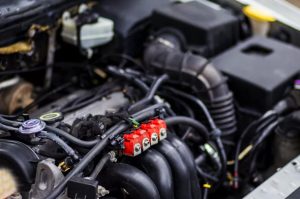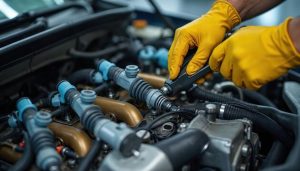The fuel injection system is one of the most critical innovations in modern internal combustion engines. It plays a central role in fuel delivery, affecting engine performance, fuel economy, and emissions. Gone are the days of carburetors; today’s fuel systems are smarter, more efficient, and integral to meeting both driver demands and environmental regulations.
In this article, we’ll explore how fuel injection systems work, their types, benefits, and common problems — and why keeping your system in top condition is vital.
What Is a Fuel Injection System?

A fuel injection system is a combination of mechanical and electronic components that deliver the precise amount of fuel to an engine’s combustion chamber. Unlike carburetors that rely on vacuum pressure, fuel injection systems spray fuel directly under high pressure, allowing for finer control over the air-fuel mixture.
Key Functions of a Fuel Injection System
| Function | Description |
|---|---|
| Fuel delivery | Provides the engine with the right amount of fuel at the right time |
| Air-fuel ratio control | Maintains an optimal ratio for combustion (typically 14.7:1 in gasoline engines) |
| Emissions reduction | Reduces harmful pollutants through precise combustion |
| Fuel economy optimization | Maximizes energy extracted from fuel, improving efficiency |
| Engine responsiveness | Enhances throttle control and engine smoothness |
Types of Fuel Injection Systems
Fuel injection systems have evolved into several types to meet specific performance and efficiency goals.
1. Single-Point Injection (Throttle Body Injection)
-
Uses one injector for the entire engine.
-
Simpler and cheaper, but less precise.
2. Multi-Point Injection (Port Injection)
-
Each cylinder has its own injector.
-
Better fuel distribution and efficiency.
3. Sequential Fuel Injection
-
Injectors fire in a specific sequence based on engine timing.
-
Improves performance and reduces emissions.
4. Direct Fuel Injection
-
Fuel is sprayed directly into the combustion chamber.
-
Offers superior control and power, common in newer gasoline and diesel engines.
Benefits of Modern Fuel Injection
Modern engines rely heavily on electronically controlled fuel injection systems. Here are the main benefits:
Precision and Efficiency
Computer-controlled systems adjust fuel delivery in real-time based on factors like throttle position, temperature, engine load, and oxygen levels.
Lower Emissions
Precise fuel metering ensures near-complete combustion, reducing pollutants like CO, NOx, and hydrocarbons.
Better Engine Performance
Fuel injection improves horsepower, torque, and throttle response compared to older carburetor systems.
Improved Fuel Economy
Efficient combustion means less fuel is wasted, saving money and resources.
Easier Cold Starts
The system automatically adjusts for temperature variations, enhancing cold-start reliability.
Key Components of a Fuel Injection System
| Component | Function |
|---|---|
| Fuel pump | Moves fuel from the tank to the injectors under high pressure |
| Fuel injectors | Spray fuel into the intake manifold or combustion chamber |
| Fuel pressure regulator | Maintains consistent pressure in the system |
| Engine Control Unit (ECU) | Processes sensor data and adjusts fuel delivery in real-time |
| Sensors (O2, MAP, TPS) | Feed the ECU with information for accurate fuel adjustment |
Signs of a Failing Fuel Injection System

Recognizing early signs of trouble can help you avoid costly repairs.
-
Rough idling or engine misfires
-
Check engine light is on
-
Poor fuel economy
-
Lack of engine power
-
Fuel leaks or strong fuel smell
Common Causes:
-
Clogged injectors
-
Faulty fuel pressure regulator
-
Dirty fuel filter
-
Failing fuel pump
-
Sensor malfunction (especially O2 or MAF sensors)
Maintenance Tips for Your Fuel Injection System
| Maintenance Task | Recommended Frequency |
|---|---|
| Fuel injector cleaning | Every 30,000 – 50,000 km |
| Replace fuel filter | Every 20,000 – 40,000 km |
| Use fuel system cleaner | Every 10,000 km or with oil change |
| Monitor warning lights | Immediate action when check engine light is on |
| Keep fuel tank clean | Avoid letting fuel level drop below 1/4 tank |
Using quality fuel and keeping your air intake system clean also contribute to the longevity of your fuel injection components.
Fuel Injection in Gasoline vs. Diesel Engines
While both gasoline and diesel engines use fuel injection, diesel systems operate at much higher pressures and rely on compression ignition, unlike gasoline’s spark ignition. Diesel fuel injection must be incredibly precise, making maintenance even more critical.
| Feature | Gasoline Injection | Diesel Injection |
|---|---|---|
| Injection Pressure | 30–100 psi | Up to 30,000 psi |
| Injection Timing | Based on spark timing | Based on compression cycle |
| Fuel Combustion | Spark-ignited | Compression-ignited |
Conclusion
The fuel injection system is the beating heart of a modern engine’s efficiency and performance. Its role in delivering fuel precisely, maintaining the correct air-fuel ratio, and optimizing emissions cannot be overstated. Whether you drive a compact sedan or a heavy-duty diesel truck, maintaining your fuel system is crucial for reliability and longevity.
Don’t wait until fuel economy drops or your engine starts sputtering.
Buy Fuel System online — Find high-quality injectors, pumps, filters, and more designed to keep your vehicle running smoothly.